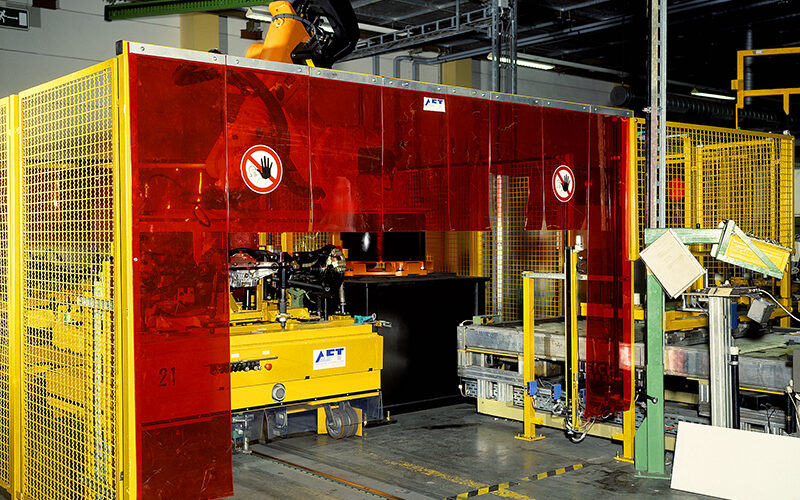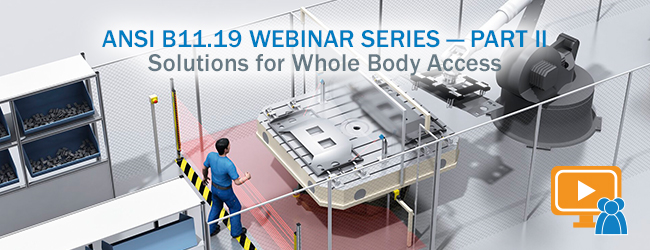Frequently asked questions about what’s new in the updated ANSI B11.19 Standard in regards to whole body access
The American National Standards Institute (ANSI) recently updated the ANSI B11.19 standard to provide more details on the application of risk reduction measures. As the main source for national standards to achieve the safety of people working with industrial equipment, the ANSI B11 Standards provide details on various aspects of machinery safety measures. The 2019 version is an effective complement to the risk assessment process by providing a near-complete list of risk reduction measures.
Watch our webinar to get more information on the ANSI B11.19 standard.
With this recent update to the ANSI B11.19 standard, we’re here to help with any questions you may have. Here are some frequently asked questions regarding how whole body access is addressed in the B11.19 standard, answered by Chris Soranno, SICK Safety Standards and Competence Manager, and Kenji Furukawa, Bridgestone Americas Sr. Technology Specialist, Safety Design.
Can an initiation warning system be used as a warning prior to both reset and restart?
Soranno: Yes, an initiation warning system can be applied in one of four ways:
- Not at all
- Prior to reset of the safety-related parts of the control system (“pre-reset”)
- Prior to restart of the hazardous condition (“pre-restart”)
- Prior to BOTH reset AND restart
In case four, added measures must be applied to aid individuals with differentiating between the pre-reset warning and the pre-restart warning, which may be audible, visual or both.
Furukawa: Additionally, the risk assessment should consider if audible warnings increase risks to operators due to high noise in the work place.
Are there any requirements or best practices for determining the amount of time allowed between activating multiple reset switches used when no location has a complete view over the area?
Soranno: Each application is unique, and therefore different. The goal is to design a system that ensures the safety of individuals, while not hindering tasks. When systems present unnecessary delays or are difficult to use (real or perceived), incentives to defeat or bypass the safety solution are introduced (A useful online resource addressing prevention of defeating risk reduction measures on machinery is available from the Section on Machine and System Safety of the International Social Security Association).
When prescribing the amount of time between activating multiple reset devices, elements to consider should include:
- the distance traveled by an individual between reset devices;
- the speed traveled by an individual between reset devices (one benchmark for walking speed is established at 4 km/h, or 1.1 m/s); and
- the size of the area to be visually inspected at each reset device location.
When a specific reset sequence is required, the control circuitry should force this sequence and have the ability to prompt for it. Time limits implemented should include upper limits to ensure the reset sequence is completed from start to finish; if a delay occurs during the sequence (e.g., lunch break), an individual could enter into a portion of the safeguarded space already visually checked.
Furukawa: I would ask my users to walk through the reset sequence and get the actual average time. Then add extra time (e.g. 5 to 15 sec) for stress-free practical operation. Review the resulting time in a risk assessment and program it into a safety controller.
In your position, do you find yourself helping solve new applications for whole body access (starting from scratch), or are there more instances of companies needing to adjust their current spaces to allow for whole body access?
Soranno: Whole body access exists in both new and existing applications. Machinery suppliers and integrators must be aware of applications where a perimeter is established with risk reduction measures where whole body access will exist. Likewise, end users need to be aware that whole body access exists in many applications – including so-called “point-of-operation” scenarios where the correct safety distance of the engineering control allows whole body access.
In the United States, OSHA places the legal requirements on employers (end users) for the overall safety of employees in the workplace. However, all stakeholders involved in the design and implementation of risk reduction measures should be aware of the added clarification addressing whole body access now addressed in the new edition of ANSI B11.19.
Furukawa: As Chris stated, whole body access exists in both new and existing applications. I find it more challenging to address existing applications due to limited resources (time, space, and funds).
How many manual reset devices can we have in a safety zone?
Soranno: The number will be dictated by the application. If a single device can be located to provide clear line of sight to the entire safeguarded area (safety zone), then a single device is sufficient – and often idea, as it does not add complexity to the process of resetting and then restarting the equipment. Multiple devices can be used to allow exit in multiple directions, as long as each has a clear view of the safeguarded area.
Additionally, multiple resets may be necessary if the entire safeguarded space is not visible from a single reset device location. In this case, multiple reset devices are required so different parts of the safeguarded space can be viewed individually, but collectively the entire zone must be clear of individuals before resetting the system. In this case, all reset devices must be actuated to enable the restart function.
Furukawa: If a similar machine is available, I would ask my users to perform a manual reset and get feedback about visibility and usability. Then they would review the resulting reset configuration in a risk assessment. If a similar machine is not available, an augmented reality tool can be helpful.
Can we use a single actuating device to initiate both manual reset and restart?
Soranno: There is no prohibition against this, but it is strongly advised to use separate devices in order to prevent accidental reset/restart due to system faults or user error. At a minimum, a time delay should be required between the two signals when using the same device. Additionally, indication of the purpose for the next input could be useful (e.g., using an illuminated push button, and using different pulse frequencies to indicate the current step in the logic sequence).
Furukawa: As Chris stated, it is not prohibited but not recommended. If a similar machine is available, I would ask my users to perform manual reset and check effectiveness of the manual reset (visual check of the safeguarded space) with my risk assessment team.
Can we have automatic reset as a safety function with whole body access?
Soranno: Automatic reset should only be applied for applications with whole body access if other risk reduction measures are used, such as preventing undetected access (e.g., there is no possibility for an individual to continue further into the safeguarded space without detection). Preventing undetected access is easiest to achieve with presence-sensing devices in a horizontal application, and is most often accomplished with safety area scanners due to their ability to monitor non-rectangular areas (as required with light curtains and pressure-sensitive floor mats).
Sequence Monitoring is a unique application of an area scanner to ensure an individual has exited a safeguarded space rather than continued further in to the cell. This function utilizes multiple protective fields of an area scanner to monitor the approach of an individual toward a hazard zone. In order for automatic reset to occur, all accessible areas of the safeguarded space must be monitored. The combined protective fields must detect the individual(s) exiting the monitored area in the expected exit sequence. If the sequence is not fully completed in the correct order, a manual reset is required. An example of Sequence Monitoring applied to a robotic application is the sBot Speed Safety System from SICK.
Furukawa: Automatic reset is permitted for presence-sensing risk reduction measures.
How do I know when enough measures have been applied for whole body access?
Soranno: ANSI B11.19 is a type-B standard describing the general best practice approach for applying risk reduction measures according to an overall hierarchy. Risk evaluation (according to ANSI B11.0 and/or ISO 12100) will determine when acceptable (tolerable) risk is achieved. Additionally, type-C standards may mandate which measures are required for a specific type of machinery.
Furukawa: At the minimum, your risk assessment team (operator, maintenance, engineer, safety, etc.) need to reach consensus that residual risk is acceptable to them.
If I follow B11.19 for whole body access (e.g. reset or presence detection), will I comply with requirements in Europe?
Soranno: In Europe, the Machinery Directive (Directive 2006/42/EC) establishes the essential health and safety requirements applicable to new equipment placed on the market in the member states of the European Union. While the new edition of ANSI B11.19 compiles the various measures for reducing risk associated with whole body access together, many existing documents existing in Europe which address many of the same topics. In the white paper associated with this presentation, Table 1 provides an alignment of the concepts in ANSI B11.19-2019 with equivalent guidance in the Machinery Directive and other international standards. Of note, all of the international (ISO and IEC) standards in the table have been harmonized as European Norms (EN standards), which allow for the presumption of conformity to the essential health and safety requirements of the Machinery Directive (see Article 7) – and therefore can be used to apply a CE mark to machinery placed on the market.
Furukawa: ANSI B11.19-2010 was much less harmonized than the 2019 edition. The 2019 edition should be followed.
 ANSI B11.19 White Paper Series
ANSI B11.19 White Paper Series
Want to learn more about the updated ANSI B11.19 standard? Read our white paper series to learn more: part 1, part 2, part 3, and part 4.






